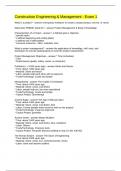Construction Engineering & Management - Exam 1
What is a project? - answer-a temporary endeavor to create a unique product, service, or result
What does PMBOK stand for? - answer-Project Management & Body of knowledge
Characteristics of a Project - answer-* a defined goal or objective
* specific tasks
* a defined beginning and ending (date)
* a defined set of deliverables
* consume resources - labor, materials, time
What is project management? - answer-the application of knowledge, skill, tools, and
techniques to execute tasks/projects to meet the project requirements
Project Management Objectives - answer-* Time (schedule)
* Cost
* Performance (quality, safety, owner, & contractor)
Prehistory ( > 5,000 years ago) - answer-Sticks and Stones
* Time: about 7,000 years ago
* Material: Stone and wood
* Labor: people help each other with no payment
* Tools/Technology: Crude and simple
Mesopotamia - answer-The Cradle of Civilization
* Time: about 5,000 years ago
* Material: Stone, wood, mud bricks
* Labor: people help out, but more specialized
* Tools/Technology: Crude and simple
* Typical Project: Stonehenge
Ancient Eqypt - answer-The Age of Manual Labor
* Time: about 4,500 years ago
* Material: Stone, wood, mud bricks, lime
* Labor: Corvee (people were forced to work on the project)
* Tools/Technology: crude but improved
* Typical Project: pyramids
Ancient Greek - answer-Master Builders
* Time: about 2,500 years ago
* Material: Stone, wood, mud bricks, lime, metal/iron
* Labor: Slaves
* Tools/Technology: Precision tools
* Typical Project: Acropolis (famous building on top of a hill, 438 BC)
The Roman Empire - answer-The Dawn of Engineering
* Time: about 2,000 years ago
* Material: Stone, wood, iron, cement/concrete, bricks
* Labor: slave and inactive soldiers
, * Tools/Technology: pulley system, lever
* Typical Project: Aqueducts
The Middle Ages - answer-Build or Die
* Time: about 1,500 years ago
* Material: Stone, wood, iron, cement/concrete, bricks
* Labor: slave and inactive soldiers
* Tools/Technology: pulley systems, levers
* Typical Projects: Chichen (Mexican Temples)
The Renaissance - answer-Rise of the Architect
* Time: about 800 years ago
* Material: stone, wood, iron, cement/concrete, bricks, tile
* Labor: more specialized
* Tools/Technology: pulley systems and levers
* Typical Projects: Cathedrals (Notre Dame)
The Industrial Revolution - answer-Bigger, Faster, Cheaper
* Time: about 200 years ago
* Material: concrete, steel
* Labor: improved skills, experts
* Tools/Technology: machine crane
* Typical Projects: Eiffel Tower
The Technological Revolution - answer-Efficiency and Inefficiency
* Time: Today
* Material: reinforced steel/concrete, glasses, composite materials, high strength steel
* Labor: union, required skills
* Tools/Technology: computer modeling, bim, cim (civil integrated model), safety
* Typical Projects: Milau Viaduct, Bird's Nest
Key Players in the Construction Industry - answer-Owners
Contractors (general and sub)
Architects
Engineers
Suppliers
Types of Construction - answer-Residential
Building (Commercial and Industrial)
Heavy Engineering and Infrastructure
Specialty
Residential (40 to 45%) - answer-* wood products, light gauge steel
* low overhead/high competition
* close relationship amount parties
* depends on economies interest rate
Institutional and Commercial (25 to 30%) - answer-* technically complicated
* many special contractors
* variety of construction materials
* required high skilled labor




